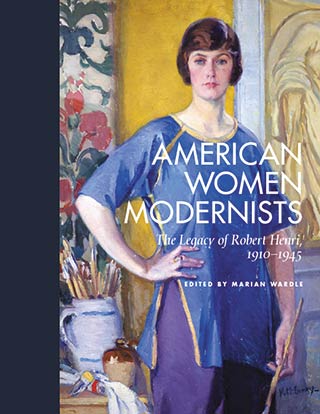ArtVoice
The Rediscovery of Kathleen McEnery
by Dean Brownrout
Kathleen McEnery's self-portrait on the cover of a book about Robert Henri, one of her mentors.
In the early 1910s, artist Kathleen McEnery was a rising presence in the New York City art community. She exhibited alongside contemporaries George Bellows, Stuart Davis, and Edward Hopper. By the time of her death in 1971, in Rochester, New York, she was almost completely forgotten as an artist outside of the region.
The Massachusetts-raised McEnery, born in 1885, was passionate about becoming an artist. She moved to New York City to study, most notably, with Ashcan School painter Robert Henri. In 1908, she traveled with Henri’s class to Madrid, and stayed on in Paris. It was the start of a promising time.
McEnery returned to New York City in 1910 and began to exhibit widely.
Her work was influenced by the realist style of Henri, but also showed modernist tendencies informed by her time abroad.
In 1913, she exhibited two paintings at the groundbreaking Armory Show in New York City. The exhibition presented over 1,000 contemporary European and American artworks—and changed the face of modern art forever. McEnery’s future as an artist seemed assured.
How did her fortunes change? While her rediscovery does appear to be happening years after her passing, her story isn’t one of a tortured artist toiling in obscurity and dying in poverty.
McEnery married automobile manufacturer Francis Cunningham and moved to Rochester, where her husband’s business was based. Like many young, affluent women, McEnery devoted herself to family and community. She painted portraits of friends. The last metropolitan exhibit during her lifetime was at the Ferargil Gallery in New York City, in 1926.
In 1995, art historian Janet Wolff discovered McEnery’s work. She spearheaded a passionate campaign of articles and exhibitions featuring it.
Douglas Howard, vice president of academic affairs at Medaille College in Buffalo, contributed a catalog essay to Wolff’s 2003 McEnery retrospective at the Hartnett Gallery in Rochester.
He says, “It’s powerful and interesting work. McEnery retreated to marriage and the provinces.” Howard cites “her geographic remove from the epicenters of modernism” as an overarching reason she did not share in the ascendancy of her contemporaries.
One of her Armory Show paintings is now in the collection of the National Museum of American Art. In 2005, a McEnery self-portrait was featured on the cover of American Woman Modernists: The Legacy of Robert Henri (Rutgers University Press). With such attention finally being paid to her work, her place in our regional art history is assured, and her position in the art world is on the rise again.
Dean Brownrout is president of 20th Century Finest (www.20thcenturyfinest.com), dedicated to researching and trading in artwork by historically important, regional artists of the 20th century.
